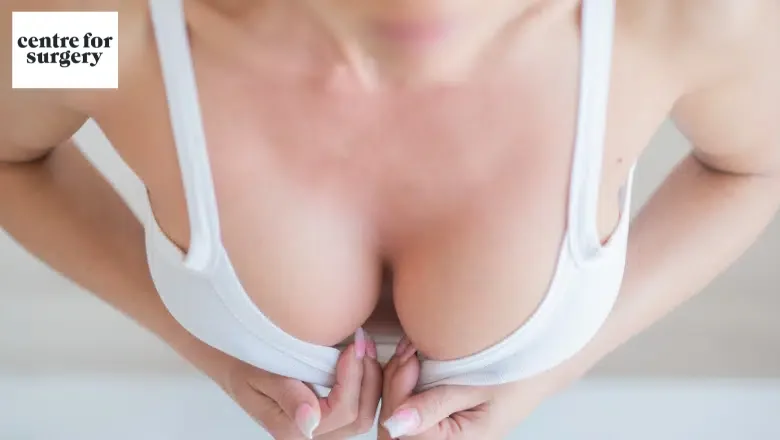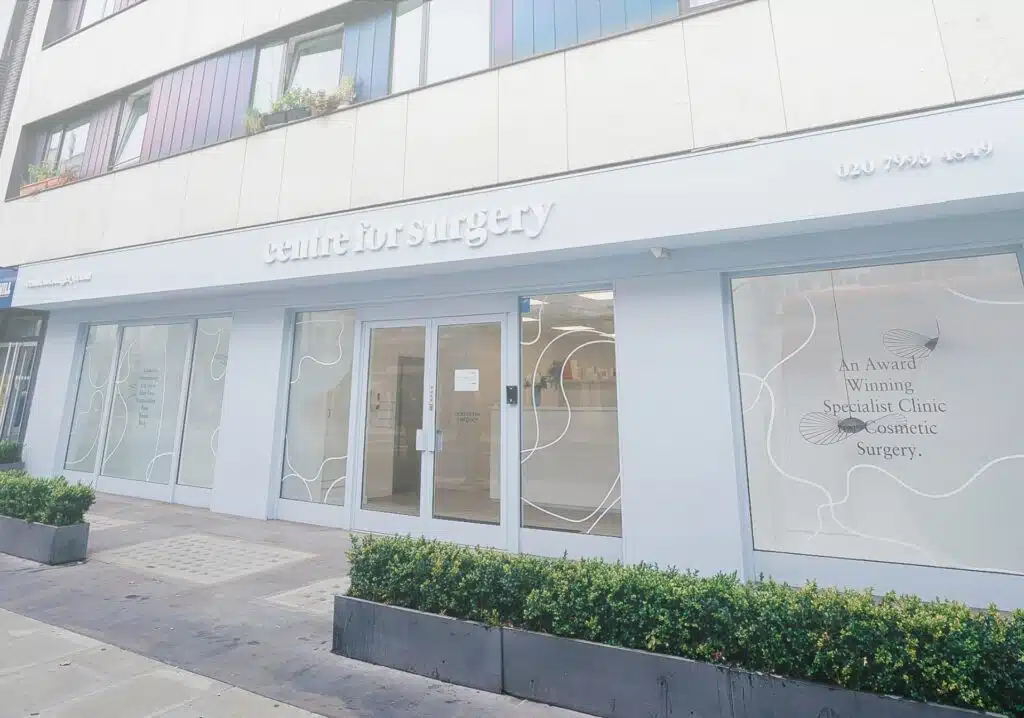Very large and heavy breasts can cause a variety of problems, including back pain and skin irritation for women in the UK. Macromastia is a medical condition and is used to describe extremely large breasts that can be a significant source of pain and discomfort for women affected by large, heavy breasts. Fortunately, there is a highly effective treatment to relieve the pain and symptoms caused by heavy breasts. Breast reduction surgery is the best way to alleviate symptoms of macromastia and can also help to improve the shape and perkiness of the breasts. Centre for Surgery is considered one of the top cosmetic surgery clinics in London, performing all types of breast surgery, including breast reduction. Breast reduction surgery can be carried out on its own or can be combined with a breast lift or breast implants for the best aesthetic outcomes.
What is Macromastia?
Macromastia is a medical term that refers to the condition of having large breasts. This can cause physical discomfort, including neck and back pain, as well as emotional distress. Macromastia is a subjective condition and is considered a medical condition when it causes significant physical or emotional discomfort.
The causes of macromastia are not well understood, but factors such as hormonal changes, genetics, and weight gain can contribute to the development of large breasts.
Macromastia can have a significant impact on a person’s quality of life, leading to physical discomfort, emotional distress, and difficulty with physical activity. Some women may experience physical symptoms such as neck and back pain, skin irritation, and bra strap grooving. They may also experience emotional symptoms such as low self-esteem, feelings of self-consciousness, and difficulty finding clothing that fits properly.
Treatment for macromastia may include lifestyle changes such as weight loss, physical therapy, and the use of a supportive bra. In severe cases, surgery may be necessary to reduce the size of the breasts and alleviate physical discomfort and emotional distress.
RELATED: What are the causes of heavy breasts?
How do large breasts cause neck and back pain?
Large breasts can cause neck and back pain due to the increased weight and strain they put on the muscles, bones, and ligaments in the back and neck. Here are some ways that large breasts can contribute to discomfort:
- Poor posture: The added weight of large breasts can cause a person to hunch forward, leading to poor posture and placing additional strain on the neck, back, and shoulders.
- Muscle strain: The muscles in the back and neck have to work harder to support the additional weight of the breasts, leading to muscle strain and discomfort.
- Joint strain: The increased weight of the breasts can put additional pressure on the spine and joints in the back, leading to strain and discomfort.
- Bra discomfort: Wearing a poorly fitting or inadequate bra can lead to discomfort and pain in the back and neck. A poorly fitting bra can cause the straps to dig into the shoulders, leading to neck and shoulder pain.
- Skin irritation: Large breasts can rub against the skin, leading to skin irritation and discomfort. This is especially true for women who engage in physical activity, as the increased movement can lead to friction and discomfort.
To alleviate discomfort caused by large breasts, it is important to maintain good posture, wear a well-fitted and supportive bra, and engage in regular exercise to strengthen the muscles in the back and neck. In severe cases, surgery may be necessary to reduce the size of the breasts and alleviate pain and discomfort.
RELATED: Can a breast reduction help with back pain?
Should you get a breast reduction?
The decision to undergo a breast reduction procedure, also known as reduction mammoplasty, is a personal one and depends on several factors, including your physical and emotional health, your goals and expectations, and the size and weight of your breasts.
Here are some factors to consider when deciding whether or not to undergo a breast reduction procedure:
- Physical discomfort: If you are experiencing physical discomfort such as neck, back, or shoulder pain, skin irritation, or bra strap grooving, a breast reduction procedure may help alleviate these symptoms.
- Emotional distress: If you are feeling self-conscious or have low self-esteem due to the size of your breasts, a breast reduction procedure may help improve your emotional well-being.
- Physical activity: If you are having difficulty with physical activity due to the size and weight of your breasts, a breast reduction procedure may help you engage in physical activity more easily and comfortably.
- Body proportion: If you are concerned that the size of your breasts is not in proportion to the rest of your body, a breast reduction procedure may help achieve a more proportionate appearance.
You should discuss your goals and expectations with a qualified plastic surgeon at Centre for Surgery to determine if a breast reduction procedure is right for you. The surgeon will also evaluate your physical health, medical history, and the size and weight of your breasts to determine if you are a candidate for the procedure.
Additionally, it is important to understand that breast reduction is a major surgical procedure and that there are risks and potential complications involved. Your surgeon will discuss these risks with you and provide you with information about the recovery process.
RELATED: Breast Reduction FAQs – Q&A about Breast Reduction Surgery
How is breast reduction surgery done?
Breast reduction surgery, also known as reduction mammoplasty, is a procedure to remove excess fat, tissue, and skin from the breasts to reduce their size and weight. The goal of the surgery is to create smaller, lighter, and more proportionate breasts that are in better balance with the rest of the body.
The procedure is usually performed under general anaesthesia and typically takes two to four hours. The specific techniques used during the procedure will depend on the size and shape of the breasts and the amount of tissue to be removed. Here is a general overview of the most common breast reduction techniques:
- Inverted T or Anchor Scar Technique: This is the most common technique used for large-breasted women. It involves an incision that circles the areola, extends downward, and then follows the natural curve of the crease under the breast. The incision pattern forms the shape of an anchor.
- Vertical Scar Technique: This technique is used for women with moderate to small breasts and involves an incision that circles the areola and extends downward in a straight line to the breast crease.
- Liposuction Technique: In some cases, liposuction may be used to remove excess fat from the breasts without the need for incisions. This technique is typically only appropriate for women with predominantly fatty breasts and minimal skin or glandular tissue.
RELATED: Liposuction breast reduction vs surgical breast reduction
After the incisions are made, the surgeon will remove excess fat, glandular tissue, and skin from the breasts. The remaining tissue will be lifted and reshaped to create smaller, lighter, and more proportionate breasts. The incisions will then be closed with sutures, and the breasts will be wrapped in a surgical dressing and supported with a surgical bra.
What to expect during recovery from a breast reduction?
Recovery from a breast reduction procedure, also known as reduction mammoplasty, typically takes several weeks. During this time, it is important to follow your surgeon’s instructions and attend all follow-up appointments to ensure a successful recovery. Here is what you can expect during the recovery process:
- Pain and discomfort: You may experience some pain and discomfort in the first few days after the procedure. Your surgeon will prescribe pain medication to help manage any discomfort.
- Swelling and bruising: Swelling and bruising is common after breast reduction surgery and should subside within a few weeks.
- Surgical dressings and drains: Your surgeon will place surgical dressings on your incisions and may also place drains to remove any excess fluid. The dressings and drains will be removed during follow-up appointments.
- Wearing a surgical bra: Your surgeon will recommend that you wear a surgical bra for support and to help minimize swelling.
- Rest and physical activity: It is important to rest and avoid strenuous physical activity during the first few weeks of recovery. Your surgeon will provide specific instructions about when you can return to work and normal physical activity.
- Follow-up appointments: Your surgeon will schedule several follow-up appointments to monitor your progress and remove any stitches or surgical dressings.
- Scarring: Scarring is a normal part of the recovery process and will become less noticeable over time. Your surgeon may recommend using silicone sheets or gels to help minimise scarring.
- Final results: The final results of your breast reduction procedure may not be fully apparent for several months, as swelling and bruises subside and the breasts settle into their new shape.
Does breast reduction leave a scar?
Yes, breast reduction surgery, also known as reduction mammoplasty, will result in scarring. The specific location, size, and visibility of the scars will depend on the type of reduction technique used and the extent of tissue removed.
Common incision patterns used for breast reduction include:
- Inverted T or Anchor Scar: This technique involves an incision that circles the areola, extends downward, and then follows the natural curve of the crease under the breast.
- Vertical Scar: This technique involves an incision that circles the areola and extends downward in a straight line to the breast crease.
- Liposuction: In some cases, liposuction may be used to remove excess fat from the breasts without the need for incisions.
The incisions from breast reduction surgery are usually closed with dissolvable sutures, and the scars fade over time. However, it is essential to keep in mind that scars will never completely disappear, and the specific appearance of the scars will depend on factors such as skin type, age, and genetics.
RELATED: What do breast reduction scars look like?
What are the complications of breast reduction?
Breast reduction surgery, also known as reduction mammoplasty, is a commonly performed procedure that can help to alleviate physical and emotional discomfort associated with large breasts. However, like any surgical procedure, breast reduction is associated with certain risks and complications, including:
- Anaesthesia complications: As with any surgical procedure performed under anaesthesia, there is a risk of complications related to the use of anaesthesia, including reactions to medications, breathing difficulties, and heart or blood pressure problems.
- Infection: An infection can occur after any surgical procedure, including breast reduction. Symptoms of an infection include redness, warmth, and swelling at the incision site, as well as a fever.
- Bleeding: Bleeding can occur after breast reduction surgery and may require a return to the operating room for a second procedure.
- Scarring: Scarring is a normal part of the recovery process from breast reduction surgery, and the specific appearance of the scars will depend on factors such as skin type, age, and genetics.
- Changes in sensation: Changes in sensation, including numbness, tingling, or increased sensitivity, can occur after breast reduction surgery and may be temporary or permanent.
- Unsatisfactory results: The final results of breast reduction surgery may not meet your expectations, and additional surgeries may be required to achieve the desired outcome.
- Recurrence of breast sagging: Over time, the weight of the breasts can cause them to sag again, and repeat surgery may be necessary.
Can breast reduction be combined with other procedures?
Yes, breast reduction can often be combined with other cosmetic procedures. Some common procedures that may be combined with breast reduction include:
- Breast lift: A breast lift, also known as mastopexy, can be performed in conjunction with a breast reduction to elevate sagging breasts and improve the shape and position of the nipples and areolas.
- Liposuction: Liposuction can be used to remove excess fat from the breasts and surrounding areas, such as the back, hips, and waist, to improve overall body contour.
- Tummy tuck: A tummy tuck, also known as abdominoplasty, can be performed in conjunction with breast reduction to tighten and smooth the abdominal muscles and remove excess skin and fat.
- Arm lift: An arm lift, also known as brachioplasty, can be performed in conjunction with breast reduction to remove excess skin and fat from the upper arms.
Combining multiple procedures can be a cost-effective and convenient to achieve multiple cosmetic goals in a single surgical session. However, the recovery process after multiple procedures may be longer and more involved.
Is breast reduction surgery available on the NHS?
Breast reduction surgery may be available on the National Health Service (NHS) in the United Kingdom, but availability can vary depending on the specific NHS Trust and local health authority.
In general, the NHS will consider funding breast reduction surgery if the patient meets certain criteria, such as having large, heavy breasts that cause physical discomfort, including neck and back pain, skin irritation, and difficulty with physical activity. Additionally, the patient must have tried other conservative measures, such as weight loss, physiotherapy, and the use of a supportive bra, without improvement.
If you are interested in breast reduction surgery and would like to discuss your options with the NHS, you should consult with your GP, who can refer you to a specialist for further evaluation and consideration. Your specialist will be able to determine if you are a candidate for NHS funding and help guide you through obtaining approval for the procedure.
It is essential to keep in mind that the availability of breast reduction surgery on the NHS may be limited due to budget constraints and waiting lists, and private treatment at a reputable plastic surgery clinic may be a better option if NHS funding is not available or if you wish to receive the procedure more quickly.
FAQS about breast reduction
Does losing weight reduce breast size?
Losing weight can potentially reduce breast size, as breasts are comprised of both glandular tissue and fat. When a person loses weight, they may experience a reduction in the overall size of their breasts as both fat and glandular tissue are lost. However, the extent to which weight loss will affect breast size can vary greatly depending on factors such as the individual’s starting size, weight loss goals, and overall body composition.
It is also important to note that weight loss can cause changes in the shape and firmness of the breasts, leading to sagging or ptosis. Wearing a well-fitting and supportive bra and maintaining good posture can help to minimise these changes.
What is the best way to treat heavy breast problems?
The best way to treat heavy breast problems depends on the individual and the specific symptoms they are experiencing. Some options for treating heavy breasts include:
- Lifestyle changes: Making changes to your diet and exercise routine can help to reduce the size of your breasts and improve overall health.
- Wearing a supportive bra: Wearing a well-fitting and supportive bra can help to reduce discomfort and provide support for the breasts.
- Physiotherapy: Physiotherapy, such as exercises to improve posture, can help to reduce discomfort and improve the strength and flexibility of the muscles that support the breasts.
- Medications: Over-the-counter pain relievers, such as ibuprofen or paracetamol, can be used to relieve discomfort associated with heavy breasts.
- Breast reduction surgery: In cases where conservative measures have not provided relief, breast reduction surgery may be recommended to reduce the size of the breasts. This can include procedures such as breast reduction or breast lift.
Breast reduction surgery is considered the most effective treatment for the relief of pain and discomfort from heavy breasts.
How big do your boobs have to be to get a breast reduction?
The size at which a person may consider a breast reduction can vary greatly depending on factors such as their overall body size, the proportionality of their breasts to their frame, and the symptoms they are experiencing. Some common reasons for seeking a breast reduction include neck and back pain, shoulder grooving from bra straps, skin irritation, and difficulty finding clothing that fits properly.
There is no specific size that a person’s breasts must be to consider a breast reduction, as the decision to undergo the procedure is based on individual factors and the extent to which the size and weight of the breasts impact their quality of life.
If you are considering a breast reduction, it is important to consult with a qualified plastic surgeon at Centre for Surgery in London who can assess your individual needs and provide guidance on the best course of treatment for your specific situation. They can also discuss the potential benefits and risks of the procedure and help you make an informed decision.
Breast Reduction Surgery at Centre for Surgery
Centre for Surgery is the leading cosmetic surgery clinic in London and is home to some of the best consultant plastic surgeons in the UK. We are renowned for our extensive experience in all types of breast reduction surgery. We perform over 100 breast reduction procedures at our state-of-the-art Baker Street clinic in Marylebone each year. Call us today on 020 7993 4849 or complete the contact form below to schedule an in-person consultation with a specialist breast reduction surgeon.










